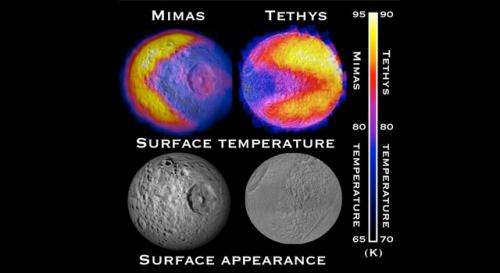Cassini finds a video gamers' paradise at Saturn

(Phys.org)—You could call this "Pac-Man, the Sequel." Scientists with NASA's Cassini mission have spotted a second feature shaped like the 1980s video game icon in the Saturn system, this time on the moon Tethys. (The first was found on Mimas in 2010). The pattern appears in thermal data obtained by Cassini's composite infrared spectrometer, with warmer areas making up the Pac-Man shape.
"Finding a second Pac-Man in the Saturn system tells us that the processes creating these Pac-Men are more widespread than previously thought," said Carly Howett, the lead author of a paper recently released online in the journal Icarus. "The Saturn system - and even the Jupiter system - could turn out to be a veritable arcade of these characters."
Scientists theorize that the Pac-Man thermal shape on the Saturnian moons occurs because of the way high-energy electrons bombard low latitudes on the side of the moon that faces forward as it orbits around Saturn. The bombardment turns that part of the fluffy surface into hard-packed ice. As a result, the altered surface does not heat as rapidly in the sunshine or cool down as quickly at night as the rest of the surface, similar to how a boardwalk at the beach feels cooler during the day but warmer at night than the nearby sand. Finding another Pac-Man on Tethys confirms that high-energy electrons can dramatically alter the surface of an icy moon. Also, because the altered region on Tethys, unlike on Mimas, is also bombarded by icy particles from Enceladus' plumes, it implies the surface alteration is occurring more quickly than its recoating by plume particles.
"Studies at infrared wavelengths give us a tremendous amount of information about the processes that shape planets and moons," said Mike Flasar, the spectrometer's principal investigator at NASA's Goddard Space Flight Center in Greenbelt, Md. "A result like this underscores just how powerful these observations are."
Scientists saw the new Pac-Man on Tethys in data obtained on Sept. 14, 2011, where daytime temperatures inside the mouth of Pac-Man were seen to be cooler than their surroundings by 29 degrees Fahrenheit (15 kelvins). The warmest temperature recorded was a chilly minus 300 degrees Fahrenheit (90 kelvins), which is actually slightly cooler than the warmest temperature at Mimas (about minus 290 degrees Fahrenheit, or 95 kelvins). At Tethys, unlike Mimas, the Pac-Man pattern can also be seen subtly in visible-light images of the surface, as a dark lens-shaped region. This brightness variation was first noticed by NASA's Voyager spacecraft in 1980.
"Finding a new Pac-Man demonstrates the diversity of processes at work in the Saturn system," said Linda Spilker, Cassini project scientist at NASA's Jet Propulsion Laboratory, Pasadena, Calif. "Future Cassini observations may reveal other new phenomena that will surprise us and help us better understand the evolution of moons in the Saturn system and beyond."
More information: www.sciencedirect.com/science/ … ii/S0019103512004204
Journal information: Icarus
Provided by JPL/NASA




















